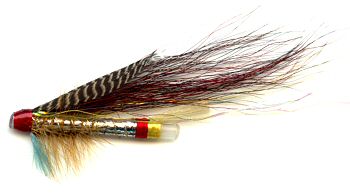The Silver Doctor 1 Plastic Tube Fly
The Silver Doctor is one of the fully dressed patterns much loved by salmon anglers of the 19th century and early 20th century. The dressings of these patterns were extremely complicated and included many exotic plumages from endangered birds.

SALTWATER, SALMON & STEELHEAD TUBE FLY
$US each. Price does not include hooks.
Modern substitute materials have enabled the Silver Doctor still to be fished. It is one of the flies that the British took to Norway and Canada at an early date with great effect. James Wright was its designer back in 1850. The silver body, red and blue coloring make this fly a very distinctive and effective attractor pattern.
I have had great success with a Silver Doctor when fishing for Salmon in Canada, Scotland and in Sweden. Bait fish have to move quickly in order to survive and your fly must do the same. Ensure you maintain your retrieve until you feel your line stop Salmon do not slam into the fly like trout or bass usually do. With Coho especially you will sometimes see a wake following your fly. Although it is exciting and can be unnerving it is important that you keep the fly moving. Do not be tempted to slow up and let the Salmon catch up. This is unnatural behavior for a bait fish and may spook your target fish into rejecting your fly. I have found Dead-drifting around the edges of swirling eddies also brings takes with this fly.
THE MODERN TEMPELDOG STYLE OF TYING TUBE FLIES
Most of our salmon tube flies are tied in the Tempeldog style. The fly has a wing that goes over the hook, throat hackle, some palmering of the body and a small tail. Swedish fishing guide and Sales rep for tackle company Guideline AB, Håkan Norling made the first tempeldog tube fly in 1985. He was making some flies for his annual autumn / fall salmon fishing trip to the River Em in Sweden. Håkan needed some goat hair but when he phoned his supplier was out of stock. They did have some Tibetan Jackal dog hair which they sent. When it arrived it was too short for the patterns he wanted to make and did not look of very good quality. He dyed it black and dark brown and tied it to a tube. Håkan was shocked at how well it worked, " I will never forget the sight of the fly in water. It looked like it was about to swim away with my leader. The wing had so much life - moving in a way I had seen with any other hair we were using at that time."
The Tempeldog style of flies that Håkan and his friend Mikael Frödin developed over the next ten years set the standard for salmon flies in Northern Europe. He called the dog hair Tempeldog. Yes the spelling is correct. Håkan was upset when he saw the shocking treatment and conditions the dog were subjected to in China. He stopped using this material and searched for a good alternative. Some old fur coats were made of dog hair so he used those for a while until he found that fox hair was an ideal replacement and a lot cheaper. With new materials becoming available a mixture of Angel hair and natural fox hair makes a light wing that will not absorb too much water. It makes it easy to cast but with enough bulk to create the correct fish silhouette.
For Håkan the silhouette and movement were the most important part of the Tempeldog design. The fish normally see the fly from below and if it looks the shape of a fish and moves like one you will catch more salmon. The silhouette is formed by the different layers of the hair wing being trimmed at different lengths. The outer section of the wing should be the longest where as the one nearest the hook shank should be the shortest. Looking from above and below the wing should form a long tear drop shape tapering to a point over the hook. Håkan likes to use jungle cock cheeks in a V formation either side of the wing to help with the suggestion of an eye but this is optional.
STEELHEAD TUBE FLIES
Tube flies have recently gained popularity for many kinds of fish. Recently this type of fly has become extremely popular for both winter and summer steelhead. Originally used so that a smaller hook could be used with a large fly to cut injury to wild steelhead, this configuration hooks fish quickly, yet decreases the injury that sometimes occurs using larger hooks. These flies are very streamlined and easy to cast. Our plastic tube models are very lightweight which gives them lots of action when the are submerged. These lightweight flies are comparatively snag free. The best way to fish these flies is with a sinking tip line. They are cast across current and allowed to swing deep under tension.

